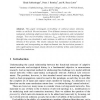Free Online Productivity Tools
i2Speak
i2Symbol
i2OCR
iTex2Img
iWeb2Print
iWeb2Shot
i2Type
iPdf2Split
iPdf2Merge
i2Bopomofo
i2Arabic
i2Style
i2Image
i2PDF
iLatex2Rtf
Sci2ools
ECAL
2005
Springer
2005
Springer
Analysing the Evolvability of Neural Network Agents Through Structural Mutations
This paper investigates evolvability of artificial neural networks within an artificial life environment. Five different structural mutations are investigated, including adaptive evolution, structure duplication, and incremental changes. The total evolvability indicator, Etotal, and the evolvability function through time, are calculated in each instance, in addition to other functional attributes of the system. The results indicate that incremental modifications to networks, and incorporating an adaptive element into the evolution process itself, significantly increases neural network evolvability within open-ended artificial life simulations.
| Added | 27 Jun 2010 |
| Updated | 27 Jun 2010 |
| Type | Conference |
| Year | 2005 |
| Where | ECAL |
| Authors | Ehud Schlessinger, Peter J. Bentley, R. Beau Lotto |
Comments (0)

